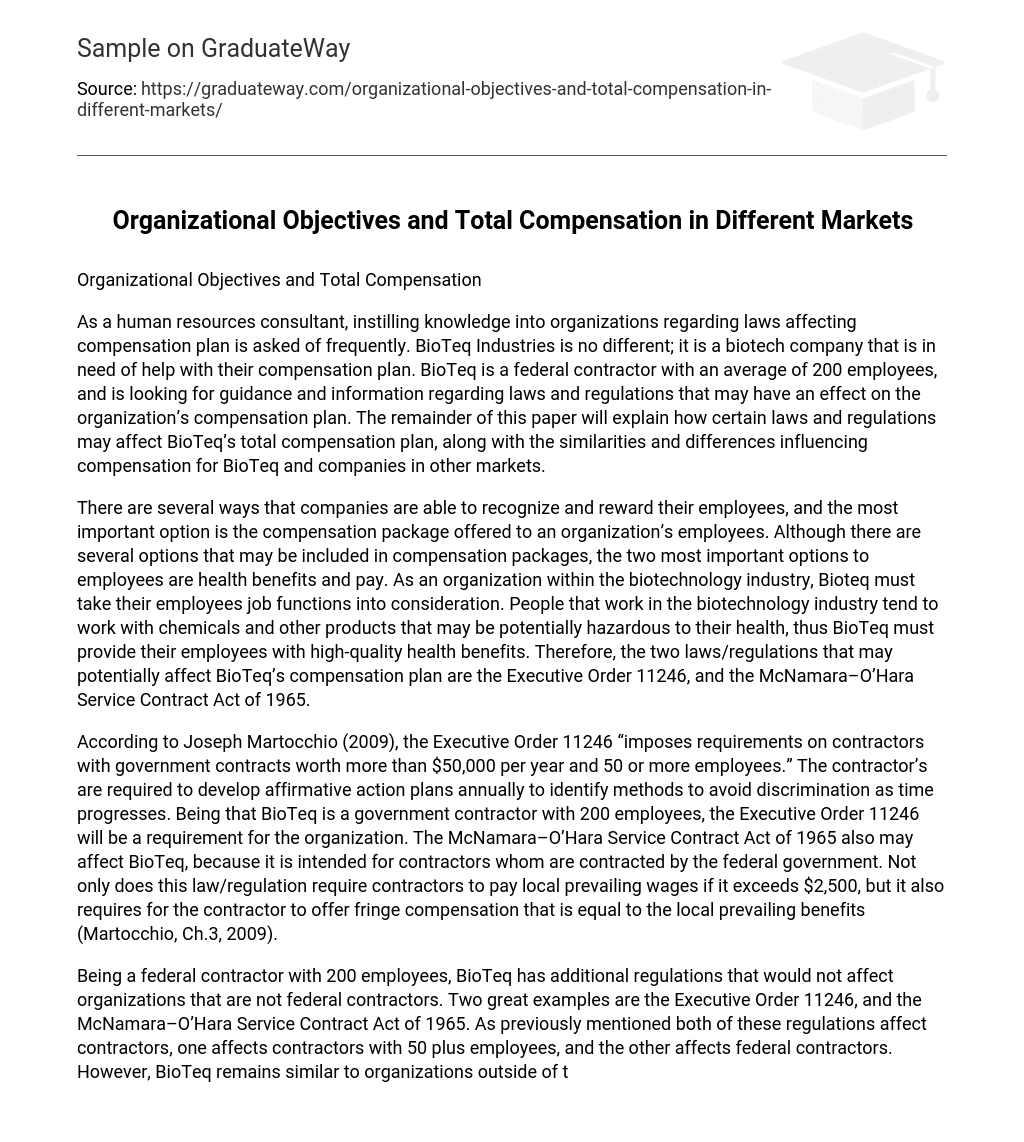Organizational objectives and total compensation are closely linked.
As a human resources consultant, I am frequently asked to provide organizations with knowledge about laws that affect compensation plans. This is also the case for BioTeq Industries, a biotech company in need of assistance with their compensation plan. BioTeq is a federal contractor with around 200 employees, and they are seeking guidance and information about laws and regulations that could impact their compensation plan. In the following sections, I will discuss how specific laws and regulations can have an impact on BioTeq’s overall compensation plan. I will also explore the similarities and differences in compensation practices between BioTeq and companies in other industries.
Companies have various ways of recognizing and rewarding employees, but the most crucial aspect is the compensation package. Health benefits and pay are the two essential options in compensation packages for employees. Since Bioteq operates in the biotechnology industry where employees handle potentially hazardous chemicals and products, providing them with top-notch health benefits is vital. Thus, BioTeq must consider two laws/regulations, namely Executive Order 11246 and the McNamara–O’Hara Service Contract Act of 1965, that could potentially impact their compensation plan.
Joseph Martocchio (2009) states that the Executive Order 11246 imposes certain obligations on contractors with government contracts worth over $50,000 per year and employing 50 or more individuals. These contractors must develop affirmative action plans annually to prevent discrimination over time. As BioTeq is a government contractor with 200 employees, it will be subject to the requirements of Executive Order 11246. Moreover, BioTeq may also be affected by the McNamara–O’Hara Service Contract Act of 1965, which applies to contractors contracted by the federal government. This legislation not only mandates contractors to pay local prevailing wages exceeding $2,500 but also requires them to offer fringe benefits that are equivalent to the local prevailing benefits (Martocchio, Ch.3, 2009).
BioTeq, a federal contractor with 200 employees, is subject to additional regulations that do not apply to non-contractor organizations. Two notable regulations are the Executive Order 11246 and the McNamara–O’Hara Service Contract Act of 1965. Both regulations impact contractors, with one specifically targeting contractors with 50 or more employees and the other applicable to all federal contractors. However, BioTeq still shares common ground with organizations outside the biotechnology industry as it must comply with the majority of existing laws and regulations. These include the Social Security Act of 1935 and the FLSA of 1938.
When establishing a compensation plan, BioTeq must consider various factors, including the nature of the employees’ work and the associated hazards. Additionally, BioTeq must take into account two regulations that apply to contractors like them: Executive Order 11246 and the McNamara-O’Hara Service Contract Act of 1965. Despite being a contractor, BioTeq is still obligated to comply with regulations like the SSA of 1935 and the FLSA of 1938. In summary, BioTeq faces numerous factors that must be deliberated upon when developing a compensation plan.
References
Martocchio, J (2009). Strategic Compensation. A Human Resource Management Approach Fifth Edition, Chapter 3: Contextual Influences on Compensation Practice. Retrieved April 30, 2012, from https://ecampus.phoenix.edu/content/eBoothekLibrary2/content/eReader.aspx #ch03lev1sec2.





